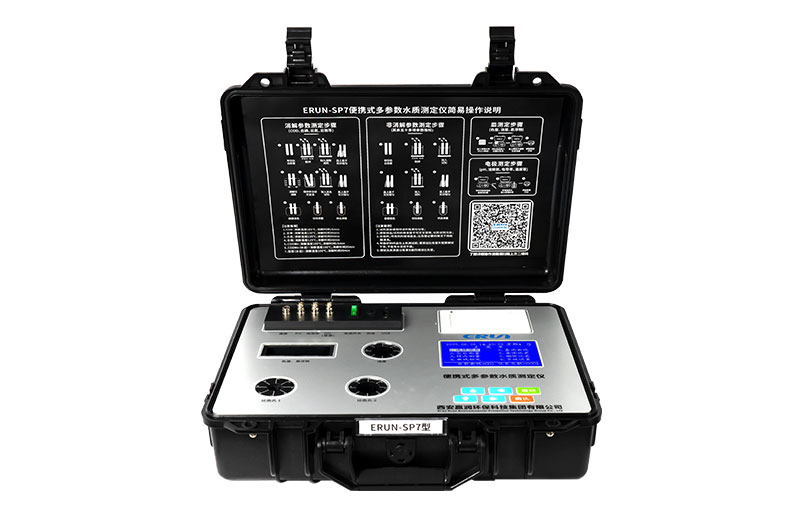Groundwater is a cornerstone of China’s water supply, providing drinking water for over 400 cities, particularly in the northern regions where it accounts for two-thirds of potable water. However, rapid industrialization, agricultural runoff, and domestic waste have led to widespread groundwater pollution, posing risks to public health and environmental sustainability. To address these challenges, China has implemented the GB/T 14848-2017 Standard for Groundwater Quality, which provides a robust framework for assessing and managing groundwater. The Ministry of Ecology and Environment (MEE) oversees a nationwide monitoring network to track groundwater quality, supported by tools like the ERUN-SP9 Portable Multi-Parameter Water Quality Tester. This article explores the standard, MEE’s monitoring efforts, and how advanced tools like the ERUN-SP9 contribute to sustainable groundwater management.

Groundwater is essential for drinking, irrigation, and industrial use in China, particularly in water-scarce regions like the North China Plain. However, pollution from agricultural fertilizers, industrial discharges, and untreated sewage threatens its safety. According to a 2020 MEE report, 43.6% of tested groundwater sites were classified as “poor” (Class V), unsuitable for drinking without treatment. Contaminants like nitrate and heavy metals can cause health issues, including digestive disorders and long-term toxicity. Effective monitoring is crucial to ensure groundwater meets safety standards and supports sustainable development.
The GB/T 14848-2017 standard, updated from its 1993 version, classifies groundwater into five quality classes based on chemical and biological parameters, ensuring its suitability for various uses. The standard includes 93 indices, divided into regular and non-regular categories, covering:
Sensory traits: Color, odor, taste.
General chemical indices: pH, total dissolved solids (TDS), total hardness.
Microbiological indices: Total coliform, E. coli.
Toxicological indices (inorganic): Nitrate, fluoride, arsenic, lead, mercury, etc.
Toxicological indices (organic): Benzene, toluene, pesticides.
Radioactive indices: Total α and β radioactivity.
The classification is as follows:
| Class | Description | Suitability |
I | Lowest pollutant content | Suitable for all uses, including drinking |
II | Lower pollutant content | Suitable for all uses |
III | Medium content | Suitable for centralized drinking water, industrial, and agricultural use |
IV | Higher content | Suitable for agricultural and some industrial uses; drinking after treatment |
V | Highest content | Not suitable for drinking; limited other uses |
This standard aligns with GB 5749-2006 (Standards for Drinking Water Quality), ensuring consistency in water quality assessments. For example, Class III water meets drinking water standards with minimal treatment, while Class V requires significant remediation.
The Ministry of Ecology and Environment (MEE) manages China’s environmental protection efforts, including a comprehensive groundwater monitoring network. As of 2020, over 10,000 monitoring stations covered major plains, basins, and karst areas, with plans to expand to 20,455 stations across 3.5 million km². The MEE’s annual State of Ecology and Environment Reports provide critical insights:
2022 Report: Groundwater quality remained stable, meeting 14th Five-Year Plan (14FYP) targets, but the proportion of Class V water slightly increased, indicating ongoing challenges.
2021 Report: 42% rise in violation fines suggested stronger enforcement, but groundwater quality lagged behind surface water improvements.
2020 Report: 33.7% of sites had “marginal” (Class IV) quality, and 43.6% were “poor” (Class V), highlighting the need for enhanced monitoring.
The MEE’s efforts focus on identifying pollution sources, such as agricultural discharge (contributing 10.7% to poor groundwater quality growth), and guiding remediation strategies. However, the scale and complexity of China’s groundwater systems require advanced, portable monitoring tools for effective management.
China faces several challenges in maintaining groundwater quality:
Agricultural Pollution: Excessive use of fertilizers leads to nitrate contamination, a major issue in rural areas.
Industrial Discharges: Heavy metals and organic pollutants from factories seep into aquifers.
Domestic Waste: Untreated sewage increases microbial and chemical loads.
Over-Exploitation: Excessive groundwater extraction exacerbates contamination by concentrating pollutants.
Regional Variations: Pollution is more severe in northern regions like the North China Plain due to intensive agriculture and industry.
These challenges necessitate precise, real-time monitoring to detect and address contamination promptly.
The ERUN-SP9 Portable Multi-Parameter Water Quality Tester, developed by Xi’an Erun Environmental Protection Technology Group, is a powerful tool for groundwater monitoring. It measures up to 40 parameters, including those critical to GB/T 14848-2017, such as:
| Parameter | Measurement Range | Unit | Maximum Error |
COD (Low) | 5-200 | mg/L | 5% |
Ammonia Nitrogen (Low) | 0.00-5.00 | mg/L | 3% (F.S) |
Total Phosphorus | 0.00-10.00 | mg/L | 5% (F.S) |
Nitrate (Nitrogen) | 0.00-10.00 | mg/L | 5% |
Fluoride | 0.00-10.0 | mg/L | 5% (F.S) |
Sulfide | 0.00-1.00 | mg/L | 5% (F.S) |

Key Features:
High Precision: Errors as low as 3% for some parameters.
User-Friendly: Equipped with a color touchscreen and intuitive software.
Data Management: Stores 1000 data sets with USB/Bluetooth transfer.
The ERUN-SP9’s ability to measure parameters like nitrate, fluoride, and COD aligns with GB/T 14848-2017, enabling rapid assessment of groundwater quality in compliance with MEE standards.
While specific case studies for the ERUN-SP9 are limited, similar portable multi-parameter testers have proven effective in various scenarios:
North China Plain: Local authorities used portable analyzers to monitor nitrate and heavy metal pollution in shallow aquifers, identifying hotspots for targeted remediation.
Karst Regions: In the Jinci spring area, researchers employed multi-parameter testers to assess mining impacts on groundwater, guiding ecological restoration efforts.
Rural Water Supply: In remote areas, portable devices ensure drinking water meets Class III standards, protecting communities from contamination risks.
A study in Nature Communications (2025) noted that agricultural discharge is the primary driver of groundwater quality decline, emphasizing the need for tools like the ERUN-SP9 to monitor and mitigate pollution.
Xi’an Erun Environmental Protection Technology Group, the maker of ERUN-SP9, has been a trusted name in water quality monitoring since 2009. While specific endorsements for the ERUN-SP9 are not widely documented, its alignment with GB/T 14848-2017 and its utility in MEE’s monitoring framework underscore its reliability. The device’s comprehensive parameter coverage and field-ready design make it a preferred choice for environmental professionals.
Groundwater quality is a critical issue in China, with significant implications for public health and sustainability. The GB/T 14848-2017 standard provides a clear framework for assessing water quality, while the MEE’s monitoring network delivers essential data for management. The ERUN-SP9 Portable Multi-Parameter Water Quality Tester enhances these efforts by offering precise, portable, and real-time monitoring, aligning with national standards and supporting MEE’s goals. By adopting such advanced tools, China can better address groundwater pollution and ensure a safe, sustainable water supply.
For more details on how the ERUN-SP9 can support your groundwater monitoring needs, visit ERUN-SP9 Product Page.